
Health 'Insurance' at Sea: 1 2 3 4 5 6 7 8 9 10 11 12 13 Next>>
Health 'Insurance' at Sea During the Golden Age of Piracy, Page 6
Intermediate Health Care - Navy: Landed Hurt and Sick Problems with Public Hospitals
To complicate matters, the public hospitals' reaction to the navy usurping their authority and demanding they set aside beds for sick and wounded sailors and soldiers soured over time. St. Bartholomew's and St. Thomas's were set up to house the ill among the very poor.1
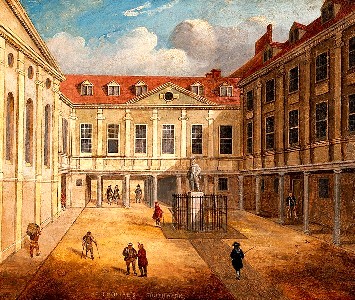
St. Thomas's Hospital During the Renaissance, Wellcome Museum
The military's demand for the reservation of half the beds and the blocking of poor patient admissions to accommodate them did nothing to improve relations with the civic hospitals.
The housing of soldiers and sailors in public hospitals such as St. Bartholomew's also disrupted the atmosphere in the hospital; sailors had "to be warned that 'if they did ...disorder themselves by drink or did lie out of their wards or did not observe the rules of this house, that they should be presently dismissed this hospital, and put out of the state's pay'."2 In 1666, the Governors of St. Thomas's hospital "'made some scruple' about receiving any more wounded seamen" at the hospital, having "in mind their repeated failure to obtain any satisfaction from the [Sick and Hurt] Commission regarding the discipline of service patients."3 Yet, the Commission requested more beds from the hospitals, promising to use them sparingly, which was agreed to so long as "in future the naval and military patients must conform strictly "to the ancient rules and orders of the house"4.
In addition, the naval cases which ended up in the hospitals tended to be 'tedious' cases such as chronic invalids who healed slowly, if at all. As a result, naval cases "tended to convert a hospital into an infirmary"5, thus occupying beds for long periods which were meant for the treatment of the sick and poor for extended periods of time.
On top of that, the government was often slow to pay the bills at the rates they had established for the hospitals. During William's War in 1696, the governors of St. Bartholomew's noted,
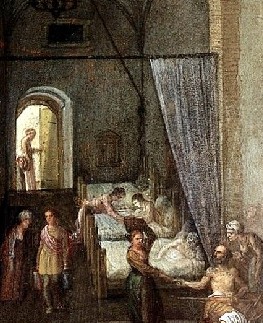
Image: Adam Elsheimer
Hospital Scene, From St. Elizabeth Visiting a
Hospital (1598)
We do find that during the present Warr great numbers of seamen and soldiers have beene received and cured in the said Hospitall and that there is due to this House £900 and upwards for the 4d. per diem promised to be paid out of the subsistence money of every soldier admitted into this House during his continuance under cure, That all due care and solicitation have beene used for the obteining thereof and by reason that the soldiers are so very much in arrears of their pay the said sume remaines unpaid, and many officers dead great part will be lost, and are of opinion that a petition ought to be presented to his Majesty for procuring the said debt.6
This didn't result in payment, so they sent a petition to the House of Commons in 1698 asking for at least partial payment "in consideration of the great charge this Howse hath beene att in curing above three thousand seamen and soldiers during the late Warr and having had no allowance for the same"7.
The problems of resistance from the hospitals was compounded by the need for even more beds than they could provide to accommodate the ill and wounded during war time. John Evelyn, who had served on both the second and third Dutch War Sick and Hurt Commissions was among the first people to recognize this problem. He wrote to Samuel Pepys on September 30, 1665 during the second Dutch War, noting: "Ha[ve] now 5.000 sick, wounded, and prisoners, dying for want of bread and shelter. This barbarous exposure must needs redound to the King's great dishonour, and to the consequence of losing the hearts of his people."4 Evelyn worked with the hospitals and had seen how they were organized, so he began pushing for building a dedicated naval hospital.8
1 Guy Williams, The Age of Agony, 1986, p. 89; 2 Kevin Brown, Poxed and Scurvied: The Story of Sickness and Health at Sea, p. 44; 3,4 1John J. Keevil, Medicine and the Navy 1200-1900: Volume II – 1640-1714, p. 108; 5 Mary Anne Everett Green, ed., Calendar of State Papers, Domestic Series, Charles II. 1664-1665, 1863, p. 577; 6,7 Keevil, p. 250; 8 Keevil, p. 104
Intermediate Health Care - Navy: Navy Hospitals for the Landed Hurt and Sick
John Evelyn was the first to foresee the problems with housing sick and hurt men in the civic hospitals and private dwellings, so he began creating a plan to build a permanent Navy hospital. On January 31st, 1666, he sent a proposal and estimates to Samuel Pepys for a naval hospital containing four to five hundred beds which was to be

Artist: Robert Nanteuil - John Evelyn (1650)
built at Chatham. These were submitted to the Navy Board (who managed the administrative affairs of the Navy), to James, then Duke of York and Lord High Admiral of the Navy and, finally, to the Navy Commissioners.1 Evelyn recorded in his diary on February 20th that
the Commissioners of the Navy, who having seene the project of the Infirmary, encouragd the worke, & were very earnest it should be set about speedily: but I saw no mony, though a very moderate expense, would have saved thousands to his Majestie and ben much more commodious for the cure and quartering our sick and wounded, than the dispersing of them into private houses, where many more Chir[ur]giones & tenders were necessary, & the people tempted to debaucherie.2
As Evelyn himself noted, while interest existed for a naval hospital, there was no money available for the project. As preparations for the third Dutch War began, he again proposed setting up hospitals to the Admiralty, but they demurred, preferring to use parts of the public hospitals of St. Thomas and St. Bartholomew and to requisition the use of the Savoy and Ely House to themselves. The money required for the initial costs of such a hospital was not there.3
As a result, all of the naval hospitals that were used through the end of the golden age of piracy were, like the Sick and Hurt Commission, primarily set up only for the duration of the war and then disbanded when it was over. In fact, the creation of the Commission itself was due in part to the failure to build such a hospital in Plymouth. In 1653,
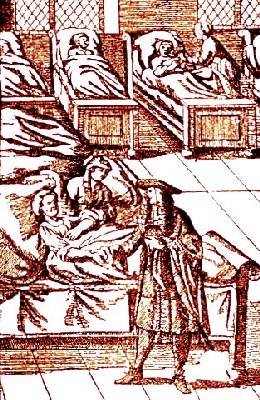
Physician Visiting Hospital, From Haus-
Feld- Koch-
Kunst- Buch (1682)
during the first Dutch War, England's Privy Council recommended that "sick-quarters were to be prepared in Plymouth castle for wounded seamen who might be landed in the west."4 This was not done, resulting in the local Navy Commissioner in charge of Plymouth writing to complain about problems of dealing with the sick and wounded. Among these complaints was a note that the men were being "quartered in "tippling houses to their great detriment'" and urging the Navy Commissioners to set up a temporary hospital there.5 They created the Commission to deal with the sick and hurt men instead.
Temporary hospitals didn't have a major role in the first two Dutch Wars. However, in preparation for the Third Dutch War in 1672 a number of 'places of reception' were set up in "London, Yarmouth, Ipswich, Southwold, Aldeburgh, Harwich, Chatham, Gravesend, Deal, Dover, Gosport, Southampton, Weymouth, Dartmouth, and Plymouth. These were to be 'for the reception of sick and wounded men set ashore from their ships.'"6 Little is known about these 'reception centres' - they may have relied upon temporary hospital-like buildings or possibly quartering in local houses. We do know that a temporary 'hospital' was established at Plymouth from the Journal of sea surgeon James Yonge, who identifies it as such. This was created in response to complaints from Admirals Arthur Herbert and Edward Russel "that there was nowhere suitable ashore to place their considerable numbers of sick "7.
Yonge discusses his involvement with this "hospital that must be set up in war" in 1671. He explains how his wife's mother wrote to "procure me the chyrurgeon's place of the hospital". He continues, "The thing was easily gotten, and I had a deputation or warrant sent me" by the third Sick and Hurt commission.8 Of the hospital itself, Yonge gives only a few details. He records that in the winter of 1672, "I had the hospital full of men, at times above 200, for the most part sick, and that of malignant diseases".9 In keeping with the temporary nature of such facilities, Yonge says in April of 1674, "a peace was concluded between us and the French, and the Hospital broke up."10
William's War brought about new concerns about the availability of hospital beds. While the Savoy and Ely House hospitals had been dedicated to military patients during the three Dutch Wars in the 17th century, they were not available during William's War, reducing the number of beds available to the Navy for the intermediate care for the hurt and sick patients. In November of 1690, the Navy Board was directed to look into the problem of housing patients. They enlisted the help of eminent physician Dr. Richard Lower. Considering
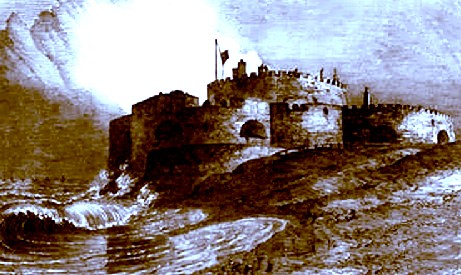
Artist: John Leech - Sandown Castle, Kent, Fitted as a Naval Hospital in 1690 (1853)
the Navy's interest in avoiding expenditure, "Lower advocated the conversion of a number of buildings [into temporary hospitals] each of which could take five hundred beds."11 Lower included several suggestions for building to be used.
While Lower's suggestions didn't work out, other temporary hospitals were set up in existing buildings in 1690, being "established at all the Principal Ports, and at Deal, Sandown Castle was fitted up, the quarter's in the town being too streight [full]'. At Plymouth, a 'large furnished house, with outhouses [referring to separate out-lying buildings] [was] purchased' by the Commissioners before the war ended' and fitted 'as a hospital for 100 men'", although the renovation wasn't completed before the end of the war.12
The temporary hospitals 'at all the Principal Ports' were again referred to as 'reception centres'. They included sites at Deptford, Gravesend, Rochester, Margate, Ramsgate, Sandwich, Dover, Rye, Gosport, Southampton, Weymouth, Dartmouth, Bideford, Falmouth, Pembroke, Liverpool, Newcastle, Hull, Yarmouth and Harwich.13 Once again, it is not entirely clear whether Principal Port sites were temporary hospitals or organized quartering plans providing the beds needed for the intermediate care of the landed sick and wounded sailors.
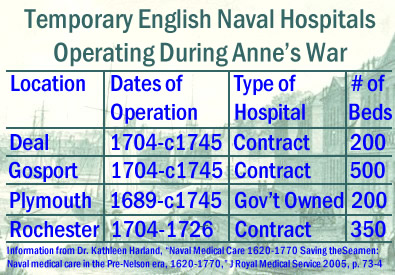
Image Artist: Ozanne Nicolas-Marie - Morlaix Port (18th c.)
Anne's War once again saw the establishment of a number of temporary naval hospitals, similar to what was done during both the Third Dutch and William's War. The fifth Commission for the Sick and Hurt added a new aspect to the process, however. The Commission "was confined to to setting up and controlling a new network of medical and administrative officers caring for the seamen in... hospitals provided solely for their use."14 To facilitate this, they "designed and developed the contract hospital system, the combination of contractor supplied buildings and furnishings and government supplied medical staff and drugs."15
Under this plan, the "civilian contractor provided the building, beds, bedding, utensils and victuals for the naval patients together with nursing care."16 The contractor system allowed the government to add temporary hospital facilities at Gosport, Deal and Rochester to the 'furnished house' at Plymouth which they paid for.17 The details of these temporary hospitals are shown in the chart.
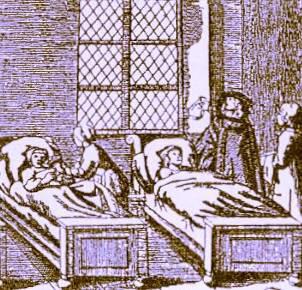
Hospital Sick Room, From Haus-
Feld- Koch-
Kunst- Buch (1682)
It is interesting that this chart (based on Dr. Kathleen Harland's research) suggests that the Plymouth hospital was open continuously from 1689 - about 1745, while John Keevil says that after William's War, "the
hospital was closed before the next war."18 If the hospital were closed and then re-opened for Anne's War, this may also account for the discrepancy between Keevil and Harland about the number of beds; Keevil says there were 100 beds during William's War while Harland says it had 200 beds. The difference may also be accounted for by fact that that the renovation of the building wasn't completed before William's War ended, being finished after the war by the hospital's surgeon, Benjamin Berry.19
Four other naval hospitals were established during Anne's War in Jamaica, Portugal, Minorca and on Gibraltar. It is notable that none of these were set up by the Sick and Hurt Council; instead they were each set up either by or at the behest of desperate naval officers.
The Jamaican hospital was proposed by Vice Admiral John Benbow, who was heading for the island in 1701 and couldn't get the Navy to provide him with a hospital ship. He was likely concerned about malaria and yellow fever experienced when he was commander-in-chief of the King's ships in the West Indies between 1698-1700. However, "the proposal was deferred as too costly"20 and a hospital ship only accompanied Benbow's
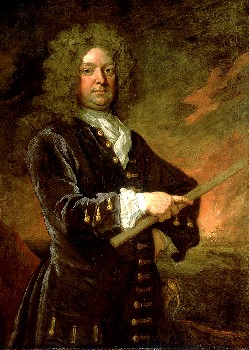
Artist: Godfrey Kneller
Admiral John Leake (late 17th/early 18th c.)
fleet part of the way. So Benbow made other plans., "On arrival, he immediately set one [a hospital] up at Kingston "21. It wasn't until after Benbow's death that the navy officially established a hospital there in 1704. In addition, due to the cost and availability of certain medicines on the island, a repository of drugs was also approved for Jamaica in 1708.22 This hospital remained in operation until near the end of the war in 1712.23
In 1705, Admiral John Leake wrote from Lisbon, Portugal "that his ships' companies were very sickly and that no convenient place was to be had ashore for their reception, although he had made the greatest application for one on his last visit"24. Leake also noted that his surgeons complained about the high price and poor availability of medicine in Lisbon. As a result of Leake's complaints, a hospital was established at Lisbon in 1706. It appears to have been a small hospital, initially run by a 'master surgeon', Thomas Elton25, "whose modest scope is further indicated by the provision that surgeons from ships should assist in the care of their own patients when landed."26 In response to the high cost of medicines at Lisbon, the Admiralty set up a repository of drugs there in 1708.27 This hospital also appears to have closed at the end of Anne's War in 1712.28
The hospital established at Port Mahon, Minorca began with a hospital captured from the Spaniards in 1708. "In 1711 work began on the construction of a purpose-built hospital on a small island
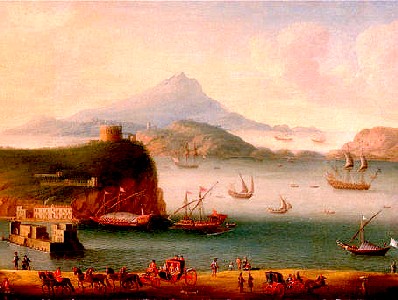
Artist: Gaspar Butler - Port Mahon, Minorca (c. 1735)
in the harbor at Port Mahon, convenient for the landing of the sick from ships, but offering a deterrent to drinkers and deserters."29 (Desertion of the landed sick and wounded from hospitals was a long-standing problem for the British Navy, no doubt due in large part to their impressment policy.) This second 330 bed hospital was not authorized by the Navy, being begun by Admiral John Jennings "at great risk to his future career". It was paid for in part by loans from officers in his squadron.30 The hospital inherited from the Spanish was closed in 1716, presumably because the second, island-based hospital was able to offer some accommodation at that time, although it was not officially opened until 1718. It lasted well beyond the end of the golden age of piracy.31
A hospital also existed at Gibraltar. The building used was initially established as a civil hospital by Juan Mateos for the residents in 1567. When the British captured Gibraltar in 1704, they took over the Juan Mateos hospital, turning it into a naval hospital in 1705.32 It remained in use by the military until 1728.33
It is worth mentioning one other hospital intended for the care of the ill and hurt since it was being built during both William's and Anne's wars: the Greenwich Naval Hospital. Renovations and building had begun in 1689, although it was not actually occupied by patients until 1705. It was used only for the long term care of sick and wounded men - basically as an infirmary - from its opening.34 Because it never functioned as a place for the intermediate care of sick and hurt men, it is discussed in detail in the section on long-term care.
1 John J. Keevil, Medicine and the Navy 1200-1900: Volume II – 1640-1714, p. 105; 2The Diary of John Evelyn, edited by Guy de la Bédoyère, 2004, p. 150; 3 Keevil, p. 129-30; 4 Keevil, p. 13; 5 Keevil, p. 19; 6 Keevil, p. 190; 7 Dr. Kathleen Harland, "Naval Medical Care 1620-1770 Saving the Seamen: Naval medical care in the Pre-Nelson era, 1620-1770," J Royal Medical Service 2005, p. 75; 8 James Yonge, The Journal of James Yonge [1647-1721] Plymouth Surgeon, 1963, p. 142; 9 Yonge, p. 143; 10 Yonge, p. 145; 11,12 Keevil, p. 194; 13 Keevil, p. 195; 14,15,16 Harland, p. 73; 17 Harland, p. 74; 18,19 Keevil, p. 194; 20 Keevil, p. 222; 21 Harland, p. 75; 22 Keevil, p. 222; 23 Harland, p. 74; 24 Keevil, p. 217-8; 25 PROB 32/54/9, The National Archives, gathered 3/6/16; 26 Keevil, p. 219; 27 Keevil, p. 222; 28 Harland, p. 74; 29 Kevin Brown, Poxed and Scurvied: The Story of Sickness and Health at Sea, p. 59; 30 Harland, p. 75; 31 Harland, p. 74; 32 "St. Bernard's Hospital", weakfishes, gathered 3/6/16; 33 Harland, p. 74; 34 Keevil, p. 200

